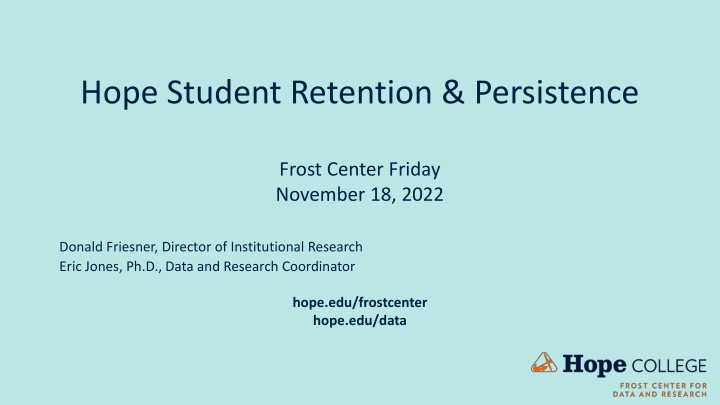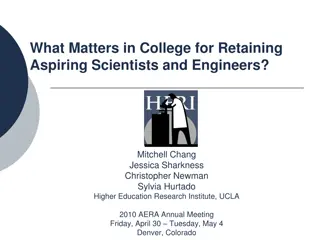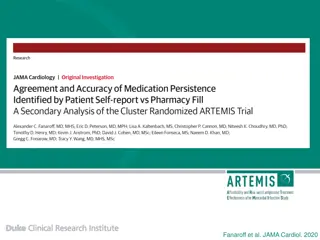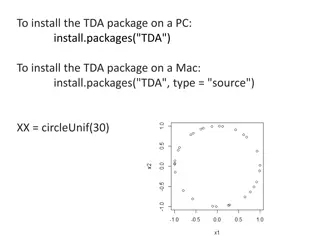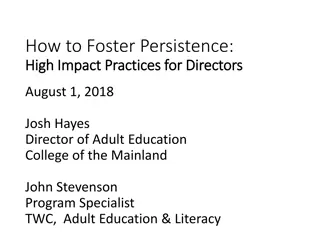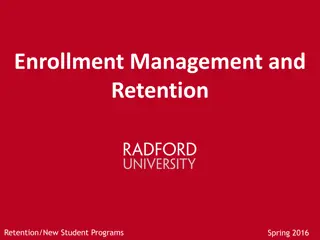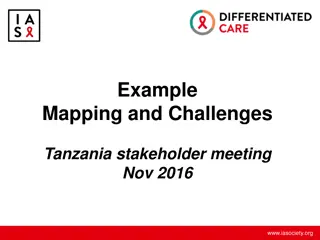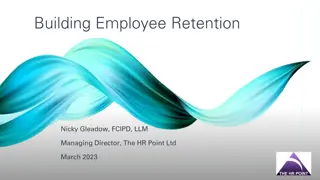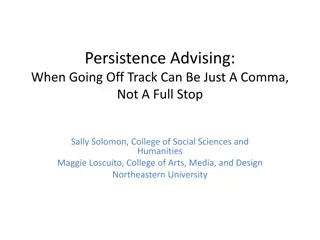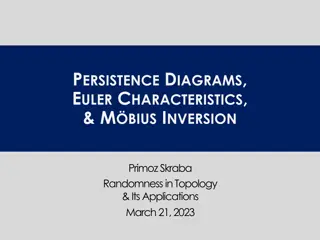Hope Student Retention & Persistence Analysis Overview
Analysis conducted by the Frost Center at Hope College on student retention and persistence, focusing on demographic variables and involvement in various activities. The retention rates by cohort and class year are outlined, along with explanations on retention calculations and measurements. The data includes information on cohort terms from 2016 to 2025, representing first-time college students.
Download Presentation

Please find below an Image/Link to download the presentation.
The content on the website is provided AS IS for your information and personal use only. It may not be sold, licensed, or shared on other websites without obtaining consent from the author.If you encounter any issues during the download, it is possible that the publisher has removed the file from their server.
You are allowed to download the files provided on this website for personal or commercial use, subject to the condition that they are used lawfully. All files are the property of their respective owners.
The content on the website is provided AS IS for your information and personal use only. It may not be sold, licensed, or shared on other websites without obtaining consent from the author.
E N D
Presentation Transcript
Hope Student Retention & Persistence Frost Center Friday November 18, 2022 Donald Friesner, Director of Institutional Research Eric Jones, Ph.D., Data and Research Coordinator hope.edu/frostcenter hope.edu/data
Overview Analysis includes students who met the following criteria: Cohort Term: F2016, F2017, F2018, F2019, F2020, or F2021 Cohort Type: First time in any college (FTC) or FOCUS Sample size = 4275 Demographic variables from Banner Race Gender First-generation status Pell grant status at cohort term State (permanent residence)
Overview Data about which activities students were involved in from Banner ASU BSU CASA Dance Marathon Greek Life Hope Catholics HIYA LSO Music Nykerk Orientation PASA Phelps Scholars Prism The Pull Spring Break Immersion Trip SOAR Athletics Student Congress Bridge WEO HAIC
Overview Retention and persistence Cohort Cohort Class Class 1 1- -Year Year Retention Retention 2 2- -Year Year Retention Retention 3 3- -Year Year Retention Retention 4 4- -Year Year Retention Retention 201608 Class of 2020 X X X X 201708 Class of 2021 X X X X 201808 Class of 2022 X X X X 201908 Class of 2023 X X X 202008 Class of 2024 X X 202108 Class of 2025 X X = included in analysis
Retention By Demographics
What is Retention? How is it Measured? Cohort: Cohort: The group of students entering in the fall term established for tracking purposes. For the Graduation Rates component, this includes all students who enter an institution as full-time, first-time degree or certificate-seeking undergraduate students during the fall term of a given year. National Center for Education Statistics Retention Rate: Retention Rate: A measure of the rate at which students persist in their educational program at an institution, expressed as a percentage. For four-year institutions, this is the percentage of first-time bachelors (or equivalent) degree-seeking undergraduates from the previous fall who are again enrolled in the current fall. National Center for Education Statistics Retention Calculation: Cohort grads + Returning Cohort/(Cohort Retention Calculation: Cohort grads + Returning Cohort/(Cohort - - Exclusions) (Death, Permanent Disability, Military Deployment, Official Church Mission) Exclusions)
Retention by Gender 100% 93.0% 90% 90.0% 87.0% 80% 79.0% 70% 60% 50% 1-Year 2-Year 3-Year 4-Year Retention Retention Female Male
Retention by Race 100% 92.0% 91.0% 88.0% 90% 88.0% 86.0% 80% 72.0% 70% 60% 50% 1-Year 2-Year 3-Year 4-Year Students of Color Non-Resident Alien White
Retention by Gender and Race Female Male 100% 100% 95.0% 93.0% 91.0% 89.0% 88.0% 90% 90% 90.0% 88.0% 85.0% 82.0% 80% 80% 76.0% 70% 70% 64.0% 60% 60% 50% 50% 1-Year 2-Year 3-Year 4-Year 1-Year 2-Year 3-Year 4-Year Retention Retention Retention Retention Students of Color Non-Resident Alien White Students of Color Non-Resident Alien White
Retention by First-Gen and Pell Status 100% 93.0% 90% 87.0% 85.0% 83.0% 84.0% 80% 78.0% 70% 68.0% 60% 50% 1-Year 2-Year 3-Year 4-Year Retention Retention Not First Gen or Pell First Gen Only Pell Only First Gen and Pell
Retention by Race, First-Gen, and Pell Status Students of Color White 100% 100% 94.0% 91.0% 93.0% 90% 90% 89.0% 86.0% 84.0% 88.0% 86.0% 85.0% 84.0% 80% 80% 77.0% 74.0% 79.0% 74.0% 73.0% 70% 70% 64.0% 60% 60% 50% 50% 1-Year 2-Year 3-Year 4-Year 1-Year 2-Year 3-Year 4-Year Retention Retention Retention Retention Not First Gen or Pell First Gen Only Not First Gen or Pell First Gen Only Pell Only First Gen and Pell Pell Only First Gen and Pell
Retention by Race and State (Permanent Residence) Students of Color White 100% 100% 93.0% 91.0% 92.0% 87.0% 90% 90% 89.0% 90.0% 86.0% 85.0% 84.0% 80% 80% 78.0% 76.0% 70% 70% 61.0% 60% 60% 1-Year 2-Year 3-Year 4-Year 1-Year 2-Year 3-Year 4-Year Retention Retention Retention Retention From Michigan From Midwest (IL, IN, OH, WI) From Other State From Michigan From Midwest (IL, IN, OH, WI) From Other State
Retention by First-Gen and Pell Status From Michigan From Midwest (IL, IN, OH, WI) From Other State 100% 100% 100% 94.0% 93.0% 90.0% 93.0% 88.0% 92.0% 90% 90% 90% 87.0% 85.0% 86.0% 85.0% 87.0% 89.0% 88.0% 80% 80% 80% 80.0% 84.0% 78.0% 75.0% 73.0% 74.0% 70% 70% 70% 65.0% 60% 60% 60% 50% 50% 50% 49.0% 40% 40% 40% 1-Year 2-Year 3-Year 4-Year 1-Year 2-Year 3-Year 4-Year 1-Year 2-Year 3-Year 4-Year Retention Retention Retention Retention Retention Retention Not First Gen or Pell First Gen Only Not First Gen or Pell First Gen Only Not First Gen or Pell First Gen Only Pell Only First Gen and Pell Pell Only First Gen and Pell Pell Only First Gen and Pell
Regression Analysis SUMMARY OUTPUT Regression Statistics Multiple R R Square Adjusted R Square Standard Error 0.169018011 0.028567088 0.027638376 0.355492335 Observations 4189 ANOVA df SS MS 3.887276 0.126375 F Significance F 2.82644E-25 Regression Residual 4 15.54910217 528.752163 30.75989 4184 Total 4188 544.3012652 Coefficients Standard Error t Stat 47.26388 2.775746 4.710242 2.118198 7.36936 P-value Lower 95% 0.974055134 0.009618743 0.031144615 0.002371428 0.090163623 Upper 95% 1.058360833 0.055883482 0.075556553 0.061347321 0.155526605 Intercept Race Gender PELL First-Gen 1.016207983 0.032751112 0.053350584 0.031859374 0.122845114 0.02150073 0.011799032 0.011326507 0.015040795 0.016669713 0 0.005532 2.55E-06 0.034217 2.05E-13
National Student Clearinghouse Summary Description Description 5 Year Average 5 Year Average Four Four- -year degree from your institution year degree from your institution 599.8 599.8 Two Two- -year degree from your institution year degree from your institution 0 0 Certificate from your institution Certificate from your institution 0 0 Four Four- -year degree from other institution year degree from other institution 69 69 Two Two- -year degree from other institution year degree from other institution 16.2 16.2 Certificate from other institution Certificate from other institution 9.2 9.2 Retained at your institution Retained at your institution 2702.8 2702.8 Retained at other four Retained at other four- -year institution year institution 272.4 272.4 Retained at other two Retained at other two- -year institution year institution 147.2 147.2
What Happens to Non-Retained Students? Top Ten Transfer-Out Colleges College College N N 85 85 40 28 26 20 14 14 12 11 11 11 187 Of those not retained over the past 10 years, 724 on to get undergraduate degrees (Certificate, Associate, or Baccalaureate). 724 went GRAND VALLEY STATE UNIVERSITY GRAND VALLEY STATE UNIVERSITY MICHIGAN STATE UNIVERSITY UNIVERSITY OF MICHIGAN WESTERN MICHIGAN UNIVERSITY FERRIS STATE UNIVERSITY CENTRAL MICHIGAN UNIVERSITY GRAND RAPIDS COMMUNITY COLLEGE WASHTENAW COMMUNITY COLLEGE DAVENPORT UNIVERSITY OAKLAND UNIVERSITY UNIVERSITY OF ILLINOIS @ URBANA Total Source: National Student Clearinghouse
Retention By Student Activities
Retention by Race and Participation in CDI Student Organizations Students of Color Non-Resident Alien White 100.0% 100.0% 99.0% 100% 100% 100% 92.0% 89.0% 88.0% 92.0% 80% 80% 80% 88.0% 87.0% 86.0% 85.0% 60% 60% 60% 68.0% 40% 40% 40% 20% 20% 20% 0% 0% 0% 1-Year 2-Year 3-Year 4-Year 1-Year 2-Year 3-Year 4-Year 1-Year 2-Year 3-Year 4-Year No Involvement No Involvement No Involvement Involvement in at Least 1 Involvement in at Least 1** Involvement in at Least 1 **Fewer than 20 students in some cells, so results may not be reliable Student Organizations: ASU, BSU, LSO, PASA, Prism, HAIC
Retention by First-Gen/Pell Status and Participation in CDI Student Organizations No Involvement Involvement in at Least 1 100.0% 100% 100% 99.0% 91.0% 92.0% 90% 90% 90.0% 87.0% 85.0% 86.0% 83.0% 80% 80% 80.0% 80.0% 78.0% 70% 70% 63.0% 60% 60% 1-Year 2-Year 3-Year 4-Year 1-Year 2-Year 3-Year 4-Year Retention Retention Retention Retention Not First Gen or Pell First Gen Only Pell Only First Gen and Pell Not First Gen or Pell First Gen Only** Pell Only First Gen and Pell **Fewer than 15 students in some cells, so results may not be reliable Student Organizations: ASU, BSU, LSO, PASA, Prism, HAIC
Retention by Race and Participation in Greek Life Students of Color Non-Resident Alien White 100.0% 100.0% 98.0% 97.0% 100% 100% 100% 91.0% 89.0% 91.0% 90.0% 80% 80% 80% 87.0% 85.0% 84.0% 60% 60% 60% 66.0% 40% 40% 40% 20% 20% 20% 0% 0% 0% 1-Year 2-Year 3-Year 4-Year 1-Year 2-Year 3-Year 4-Year 1-Year 2-Year 3-Year 4-Year Not in Greek Life Not in Greek Life Not in Greek Life Involved in Greek Life Involved in Greek Life** Involved in Greek Life **Fewer than 5 students per cell, so results may not be reliable
Retention by First-Gen/Pell Status and Participation in Greek Life Not in Greek Life Involved in Greek Life 100% 100% 99.0% 98.0% 95.0% 92.0% 91.0% 90.0% 90% 90% 90.0% 88.0% 85.0% 81.0% 80% 80% 80.0% 80.0% 74.0% 70% 70% 61.0% 60% 60% 1-Year 2-Year 3-Year 4-Year 1-Year 2-Year 3-Year 4-Year Retention Retention Retention Retention Not First Gen or Pell Pell Only First Gen Only First Gen and Pell Not First Gen or Pell Pell Only First Gen Only First Gen and Pell
Retention by Race and Participation in Athletics Students of Color Non-Resident Alien White 100.0% 100% 100% 100% 92.0% 93.0% 88.0% 87.0% 90.0% 75.0% 80% 80% 80% 87.0% 86.0% 83.0% 84.0% 70.0% 60% 60% 60% 40% 40% 40% 20% 20% 20% 0% 0% 0% 1-Year 2-Year 3-Year 4-Year 1-Year 2-Year 3-Year 4-Year 1-Year 2-Year 3-Year 4-Year Not in Athletics Not in Athletics Not in Athletics Involved in Athletics Involved in Athletics** Involved in Athletics **Fewer than 15 students per cell, so results may not be reliable
Retention by Race, Gender, and Participation in Athletics Female Male Students of Color White Students of Color White 100% 100% 100% 100% 94.0% 93.0% 91.0% 90.0% 86.0% 86.0% 83.0% 93.0% 88.0% 88.0% 80% 80% 80% 80% 86.0% 71.0% 83.0% 79.0% 75.0% 60% 60% 60% 60% 58.0% 40% 40% 40% 40% 20% 20% 20% 20% 0% 0% 0% 0% 1-Year 2-Year 3-Year 4-Year 1-Year 2-Year 3-Year 4-Year 1-Year 2-Year 3-Year 4-Year 1-Year 2-Year 3-Year 4-Year Not in Athletics Not in Athletics Not in Athletics Not in Athletics Involved in Athletics Involved in Athletics Involved in Athletics Involved in Athletics
Retention By Activity Count
Retention and Number of Activities Activity Count 1-Year 88.0% 87.3% 94.6% 96.4% 97.8% 98.8% 100.0% 100.0% 100.0% 100.0% 2-Year 84.2% 81.0% 89.2% 92.1% 95.5% 98.8% 96.8% 100.0% 100.0% 100.0% 3-Year 85.2% 79.2% 86.7% 89.3% 93.5% 97.3% 96.4% 80.0% 100.0% 100.0% 4-Year 84.6% 77.0% 86.2% 87.0% 92.9% 93.8% 90.0% 100.0% 0.0% 100.0% 0 1 2 3 4 5 6 7 8 9 Only 1-5 students per cell in these rows
Key observations In general, retention rates were lower for: Male students Students of Color First generation students with Pell grants Students involved in campus activities tended to have higher retention rates, but there were some exceptions for The Pull, athletics, and student congress. With a sweet spot in the range of 4-6 activities First-Gen and Pell students who were not involved in student activities, did worse than others. The majority of students not retained are continuing their education elsewhere. While these students are a loss to Hope, their education here, is not.
Discussion, conversation, questions Who at Hope College (positions or departments) would benefit from the information shared today? Thinking about your own work at Hope, how might you use what you ve learned today? How might data from this survey continuously inform decisions to benefit Hope students?
